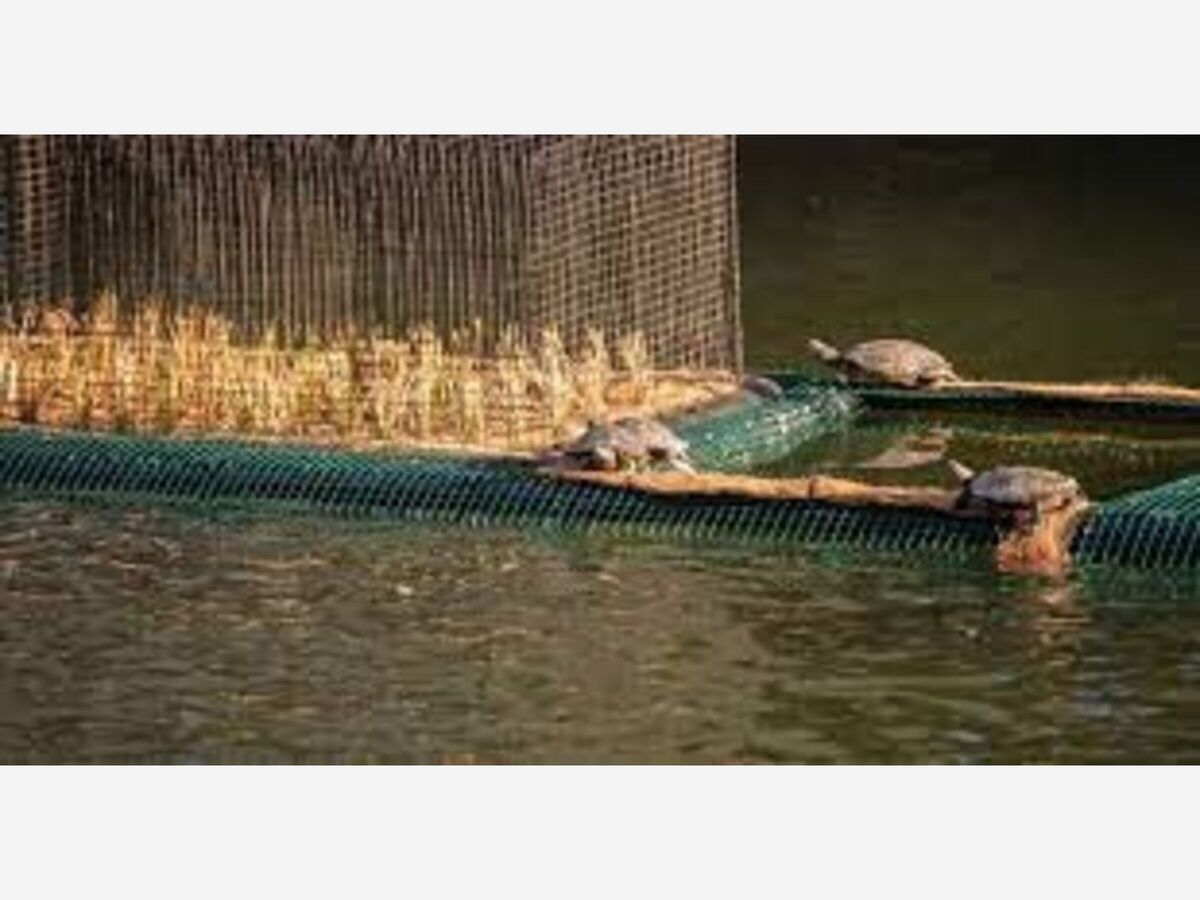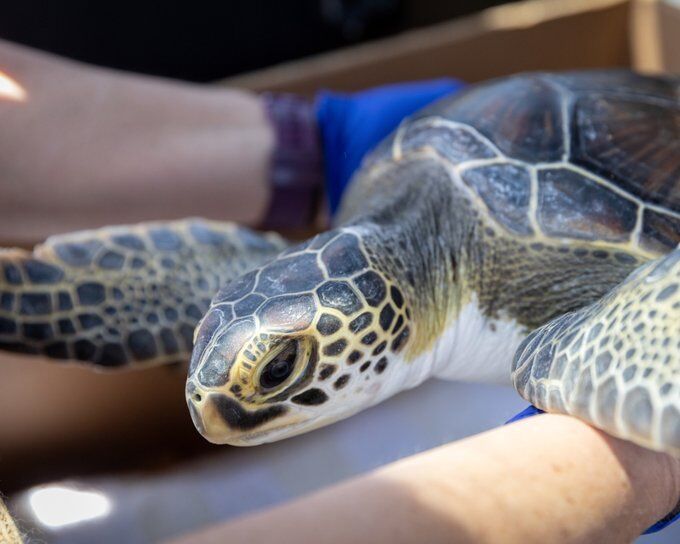Image

Thanks to a collaboration led by the Waterfront Partnership of Baltimore and supported by the Aquarium, turtles in the Inner Harbor now have a new floating island where they can chill—or really, warm up.
For people, basking in the sun might be a relaxing way to unwind, but for aquatic turtles here in the mid-Atlantic region, it's a post-winter necessity.
Thanks to a collaboration led by Waterfront Partnership of Baltimore and supported by the National Aquarium, Clearwater Mills and Living Classrooms Foundation, turtles in the Inner Harbor now have a brand-new, bona fide basking spot.

Thirty turtles sunning themselves on an orange trash boom last April helped spark the idea for the project, which re-creates a microhabitat once provided by log jams and fallen trees on the marshy shore in the harbor's pre-industrial days.
The 100-square-foot floating turtle island was funded by Waterfront Partnership and constructed at the Aquarium's Animal Care and Rescue Center over several weeks earlier this spring. In April, the structure was transported to and installed in the canal that runs between Living Classrooms' campus and Lancaster Street. The turtle island is located in the section of the canal between Eden and South Caroline streets.
This narrow canal is all that remains of a much larger canal that once extended all the way to the Jones Falls, the small river that empties into the east side of the Inner Harbor. When a long-ago storm caused a section of the canal's south wall to collapse, Living Classrooms planted trees and native plants to create a living shoreline.
"Now that the trees have grown and some have fallen into the water, they provide basking habitat for turtles," says National Aquarium General Curator Jack Cover, who led the Aquarium's involvement in the turtle island project. "There's also a sloping hillside that female turtles can use for nesting. The restoration of these microhabitats is most likely why there appears to be a growing population of aquatic turtles in the canal."
He adds, "It's hard to see most aquatic species living below the surface, but the turtles emerging from the water to bask are showing us that there's a surprisingly large number of aquatic turtles living in the Lancaster Street canal."
To meet these turtles' needs, the new turtle island has three distinct sections. A floating wetland section—modeled after the prototype that's part of the Aquarium's waterfront campus—is planted with native marsh grasses to provide refuge for juvenile turtles. It's currently enclosed in fencing to protect the young, emerging grasses from hungry Canada geese.
There are also underwater decks covered in a shallow layer of oyster shells and empty PVC pipes. This submerged level provides a growing surface for algae—an abundant food source for omnivorous turtles—and will be colonized by grass shrimp, mud crabs, mussels, small fishes and American eels. This section is also a turtle sleeping habitat. The area of the island above the water's surface provides narrow sections of basking habitat for small turtles and large basking decks for large ones.
"Essentially what we have built is a floating salad bar and a double-decker garage for aquatic turtles," Jack says.
Aquatic turtles bask for multiple reasons. After riding out the winter months hibernating in the muddy, silty bottom of their aquatic habitats, turtles need to raise their body temperatures by soaking up some sun when spring arrives. Turtles are ectotherms, which means that their body temperature isn't internally regulated. Instead, they move to warm environments when cold and retreat to cooler environments when overheated.
"Springtime activities like feeding and egg development require higher body temperatures," Jack explains. "When a turtle emerges from the cold water, it fully extends its head and legs to capture the sun's heat. The webbed hind feet are stretched out like solar panels to capture a maximum amount of sun. Blood vessels under the skin dilate and their heart rate increases to quickly deliver warmed blood to the body core to rapidly raise body temperatures."
He adds, "The sun also dries out their skin and shell and helps to eliminate excessive algal growth or external parasites, like leeches. And turtles use ultraviolet rays from sunlight to make vitamin D, which is needed to metabolize calcium from their food to add to their bones and shell."
The platform has been well-received by turtles as well as passersby.
"I walk by the canal nearly every day and had seen the turtles basking on the trash booms before," says the Aquarium's Director of Field Conservation Charmaine Dahlenburg. "They've really taken to the new island. I've seen lots of turtles, along with groups of people stopping to look at them."
If you'd like to check out the basking turtles for yourself, Jack recommends any sunny spring day when temperatures are warm but not too hot.
"The water is cold, and these turtles haven't eaten since fall, so you will see them out in greater numbers and for long periods of time when it's sunny and warm," he says. "Once the water warms up and days get hotter, the turtles will bask less frequently and for shorter periods."
Maryland is home to 18 native species and subspecies of turtles, as well as three introduced species that have become naturalized. Several aquatic species can be found in the Inner Harbor, including natives such as Eastern painted, red-bellied cooters and snapping turtles, and non-native red-eared sliders. On rare occasions, eagle-eyed observers can spot Maryland's state reptile, the diamondback terrapin, in the harbor.
The Aquarium's involvement in this project aligns with our work on our waterfront campus, where we're constructing habitats to help re-create the many natural Chesapeake Bay microhabitats that were once plentiful in the heart of Baltimore City.